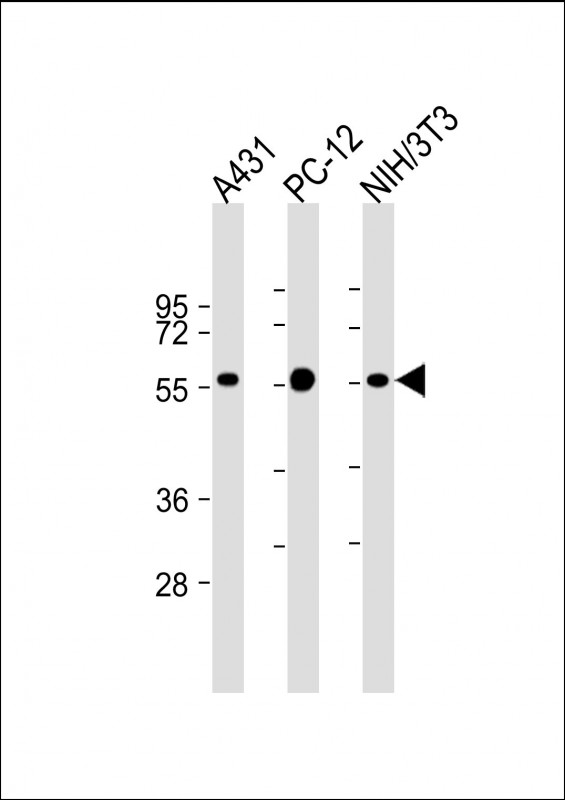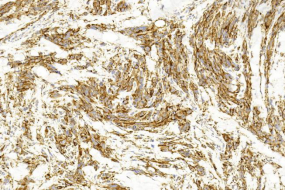

| WB | 1/2000 | Human,Mouse,Rat |
| IF | 咨询技术 | Human,Mouse,Rat |
| IHC | 1/1000 | Human,Mouse,Rat |
| ICC | 技术咨询 | Human,Mouse,Rat |
| FCM | 咨询技术 | Human,Mouse,Rat |
| Elisa | 咨询技术 | Human,Mouse,Rat |
| Aliases | Microphthalmia-associated transcription factor, Class E basic helix-loop-helix protein 32, bHLHe32, MITF, BHLHE32 |
| Entrez GeneID | 4286 |
| WB Predicted band size | 58.8kDa |
| Host/Isotype | Mouse IgG1 |
| Antibody Type | Primary antibody |
| Storage | Store at 4°C short term. Aliquot and store at -20°C long term. Avoid freeze/thaw cycles. |
| Species Reactivity | Human, Mouse, Rat |
| Immunogen | This MITF antibody is generated from a mouse immunized with a recombinant protein of human MITF. |
+ +
以下是3篇涉及MITF抗体的研究文献及简要摘要:
---
1. **文献名称**: *MITF: A Critical Transcription Factor in Melanoma Development and Progression*
**作者**: Garraway LA, Widlund HR
**摘要**: 研究探讨MITF在黑色素瘤中的调控作用,通过免疫组化(使用MITF抗体)证实MITF是黑色素细胞分化和肿瘤进展的关键标志物,并揭示其与靶基因的相互作用机制。
---
2. **文献名称**: *Developmental validation of MITF antibody for diagnostic applications in melanocytic lesions*
**作者**: King R, Fisher DE
**摘要**: 验证MITF抗体在病理诊断中的特异性,证明其在区分良恶性黑色素瘤中的有效性,并优化抗体在组织切片染色中的实验条件。
---
3. **文献名称**: *Regulation of MITF by transcriptional and post-translational mechanisms*
**作者**: Levy C, Khaled M
**摘要**: 通过Western blot和免疫荧光(使用MITF特异性抗体),揭示MITF的磷酸化修饰对其功能的影响,及其在黑色素细胞应激响应中的动态调控。
---
4. **文献名称**: *MITF Antibody-based detection of melanocyte stem cells in hair follicles*
**作者**: Nishimura EK, Jordan SA
**摘要**: 利用MITF抗体标记小鼠毛囊中的黑色素干细胞,证实MITF是维持干细胞特性及再生能力的关键因子,为组织修复研究提供工具支持。
---
以上文献均涉及MITF抗体的实验应用,涵盖诊断、机制研究及细胞标记等领域。如需具体引用格式或全文链接,可进一步补充数据库检索信息。
The microphthalmia-associated transcription factor (MITF) is a key regulator of melanocyte development, differentiation, and survival. Belonging to the basic helix-loop-helix leucine zipper (bHLH-Zip) family, MITF controls the expression of genes critical for melanin synthesis, such as *TYR*, *TYRP1*, and *MLANA*, while also autoregulating its own expression. It plays a multifaceted role across cell types: in melanocytes, it drives pigment production; in osteoclasts, it influences bone resorption; and in mast cells, it modulates immune responses.
MITF antibodies are essential tools for studying its expression and function in both normal and pathological contexts. In research, these antibodies are used in techniques like immunohistochemistry (IHC), Western blotting, and immunofluorescence to localize MITF in tissues or assess its protein levels. Clinically, MITF serves as a diagnostic marker for melanoma, as its overexpression is linked to tumor progression and metastasis. Antibodies targeting MITF help distinguish melanoma from other malignancies and are valuable in studying rare disorders like Waardenburg syndrome and Tietz syndrome, which arise from *MITF* mutations.
However, MITF’s functional complexity—such as its multiple isoforms and context-dependent roles—requires careful validation of antibody specificity. Researchers must account for isoform variability and cross-reactivity risks to ensure accurate results in experimental or diagnostic settings.
×